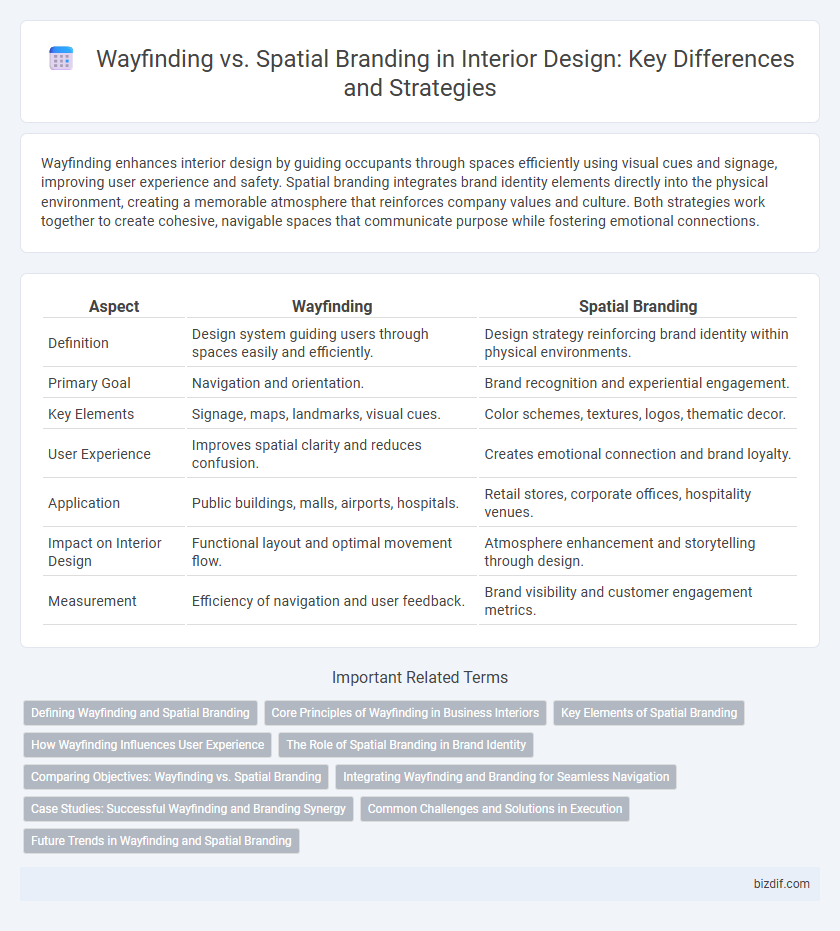Wayfinding enhances interior design by guiding occupants through spaces efficiently using visual cues and signage, improving user experience and safety. Spatial branding integrates brand identity elements directly into the physical environment, creating a memorable atmosphere that reinforces company values and culture. Both strategies work together to create cohesive, navigable spaces that communicate purpose while fostering emotional connections.
Table of Comparison
| Aspect | Wayfinding | Spatial Branding |
|---|---|---|
| Definition | Design system guiding users through spaces easily and efficiently. | Design strategy reinforcing brand identity within physical environments. |
| Primary Goal | Navigation and orientation. | Brand recognition and experiential engagement. |
| Key Elements | Signage, maps, landmarks, visual cues. | Color schemes, textures, logos, thematic decor. |
| User Experience | Improves spatial clarity and reduces confusion. | Creates emotional connection and brand loyalty. |
| Application | Public buildings, malls, airports, hospitals. | Retail stores, corporate offices, hospitality venues. |
| Impact on Interior Design | Functional layout and optimal movement flow. | Atmosphere enhancement and storytelling through design. |
| Measurement | Efficiency of navigation and user feedback. | Brand visibility and customer engagement metrics. |
Defining Wayfinding and Spatial Branding
Wayfinding in interior design involves creating intuitive navigation systems that guide users through a space using visual cues, signage, and architectural elements. Spatial branding integrates brand identity directly into the physical environment, reinforcing brand values and experience through design features like color schemes, textures, and thematic layouts. Both strategies enhance user engagement but serve distinct purposes: wayfinding improves orientation and movement, while spatial branding strengthens emotional connection and brand recognition.
Core Principles of Wayfinding in Business Interiors
Effective wayfinding in business interiors relies on clear visual cues, consistent signage, and intuitive spatial organization to enhance user navigation and reduce stress. Core principles include legibility, simplicity, and strategic placement of directional elements that align with the architectural layout and brand identity. Integrating these elements improves overall customer experience while reinforcing spatial branding through cohesive design language.
Key Elements of Spatial Branding
Spatial branding integrates key elements such as consistent color schemes, logo placement, and signature textures to create a cohesive brand experience within physical environments. Wayfinding focuses primarily on navigational aids like signage, symbols, and clear pathways that guide users efficiently through a space. Emphasizing spatial branding's visual identity components enhances emotional engagement and reinforces brand recognition beyond mere directional cues.
How Wayfinding Influences User Experience
Wayfinding enhances user experience by providing clear, intuitive navigation cues that reduce confusion and improve spatial orientation within a space. Effective wayfinding systems incorporate visual elements like signage, color coding, and architectural features that seamlessly guide users while reinforcing the overall interior design theme. This strategic integration not only facilitates movement but also enriches emotional comfort and engagement, distinguishing wayfinding from broader spatial branding efforts.
The Role of Spatial Branding in Brand Identity
Spatial branding plays a crucial role in enhancing brand identity by creating immersive environments that reflect a company's values and aesthetic. By integrating distinctive design elements such as color schemes, textures, and signage, spatial branding fosters emotional connections and reinforces customer loyalty. This approach goes beyond traditional wayfinding by transforming physical spaces into powerful brand experiences that communicate identity at every touchpoint.
Comparing Objectives: Wayfinding vs. Spatial Branding
Wayfinding in interior design aims to enhance navigation efficiency by using clear signage, landmarks, and spatial cues to guide users seamlessly through a space. Spatial branding focuses on creating an immersive brand experience by integrating visual identity elements, materials, and design motifs that reflect a company's ethos within the environment. While wayfinding prioritizes functional clarity and user orientation, spatial branding emphasizes emotional connection and reinforcing brand perception within the interior.
Integrating Wayfinding and Branding for Seamless Navigation
Integrating wayfinding and spatial branding creates a cohesive user experience by embedding brand elements into navigational signage and environmental graphics, enhancing both guidance and brand recognition. Effective spatial branding leverages color schemes, logos, and typography aligned with wayfinding systems to ensure intuitive navigation while reinforcing corporate identity. This synergy reduces cognitive load for users and transforms interior spaces into immersive brand environments, promoting seamless movement and lasting brand impressions.
Case Studies: Successful Wayfinding and Branding Synergy
Case studies in interior design reveal that successful wayfinding systems integrate spatial branding elements to create cohesive, intuitive environments that enhance user experience and reinforce brand identity. For example, the Singapore Changi Airport merges graphic signage with architectural motifs to guide passengers seamlessly while reflecting the airport's luxury brand ethos. Another instance is Apple's flagship stores, where minimalist wayfinding complements the brand's sleek aesthetic, promoting both functionality and brand recognition.
Common Challenges and Solutions in Execution
Wayfinding and spatial branding both face the common challenge of maintaining consistency while ensuring clarity in diverse environments. Solutions include integrating cohesive visual cues like color schemes, typography, and material choices that align with brand identity without overwhelming navigational function. Employing user-centered design principles and iterative testing helps optimize both directional ease and brand reinforcement simultaneously.
Future Trends in Wayfinding and Spatial Branding
Emerging technologies such as AI-driven interactive maps and augmented reality are revolutionizing wayfinding by enhancing user navigation and personalization in complex interior spaces. Spatial branding is increasingly leveraging multisensory design elements and dynamic digital displays to create immersive, memorable environments that strengthen brand identity. The convergence of data analytics with real-time environmental feedback is driving adaptive wayfinding and branding solutions tailored to evolving user behaviors and cultural trends.
wayfinding vs spatial branding Infographic

 bizdif.com
bizdif.com